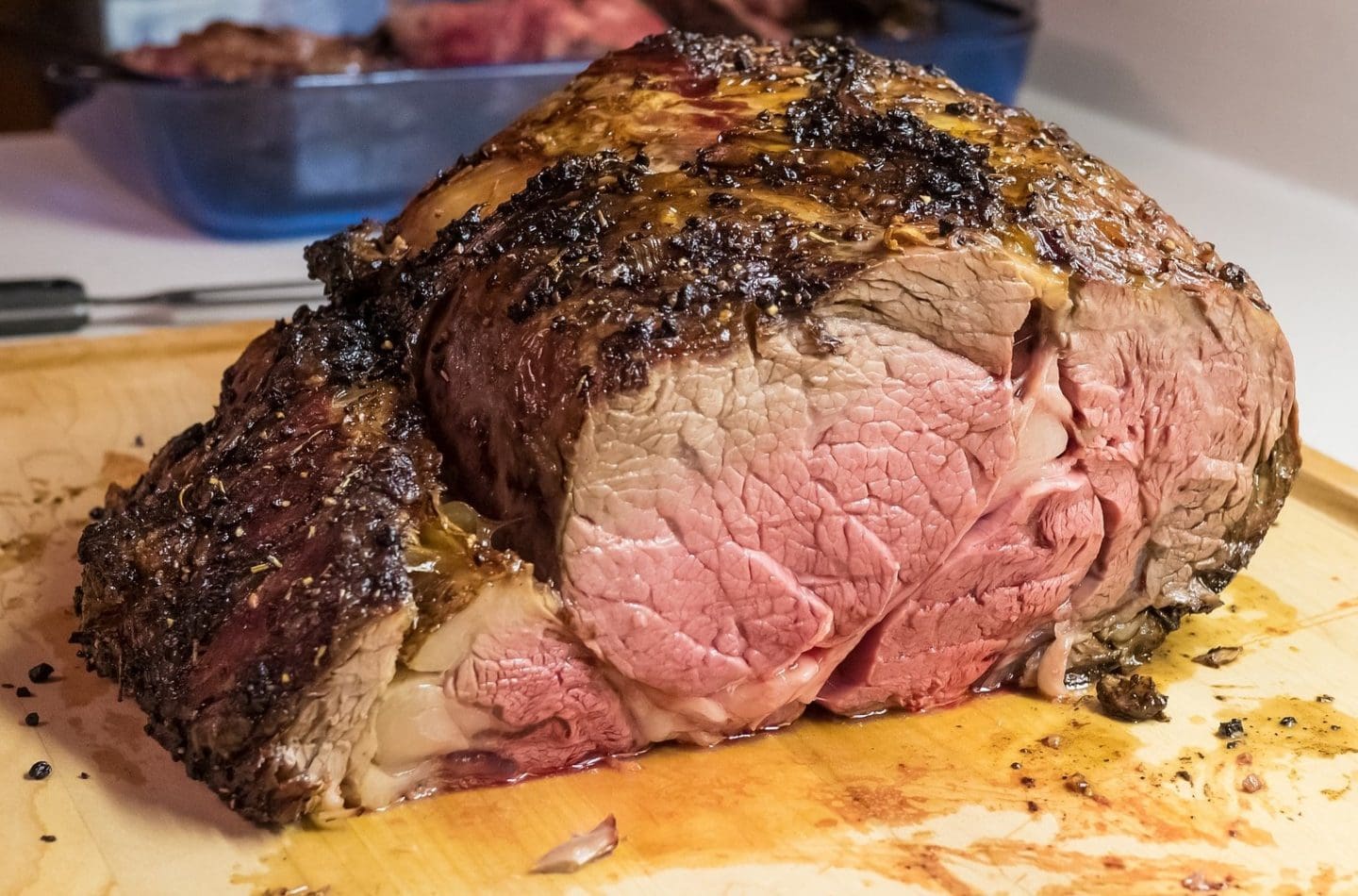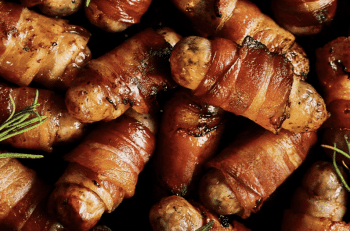Beef for Christmas dinner is a popular choice for many households in the UK who want to enjoy it as their festive feast.
But how do you choose the best beef for your Christmas dinner, and how do you cook it to perfection?
Here are some tips from the team at Christmas.co.uk on what to look for when buying beef for your festive dinner table – and how to cook and present it.
Why do people choose to eat beef for Christmas lunch?
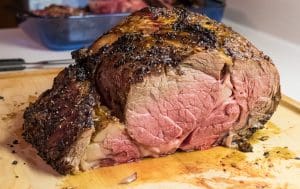 There are many reasons why people choose to eat beef for Christmas lunch. Some of them are:
There are many reasons why people choose to eat beef for Christmas lunch. Some of them are:
Taste: Beef has a rich and satisfying flavour that appeals to many palates. It can also be enhanced by various seasonings, sauces and accompaniments such as horseradish sauce, Yorkshire pudding or red wine gravy
- Variety: Beef offers a wide range of cuts and dishes that suit different preferences and budgets. Not only can you choose from a premium roast, but you can make an impression by dishing up a budget-friendly stew or a fun burger, for your festive meal
- Tradition: Beef has a long history of being associated with festive celebrations in the UK. For example, roast beef was a common dish for Christmas dinner in the 18th and 19th centuries, before turkey became more popular.
- Leftovers: Roast beef leftovers are perfect for creating delicious sandwiches and other dishes, ensuring that the festive feast continues even after the main event.
- Alternative: Beef can also be a good alternative for those who do not like or cannot eat turkey or other meats. For example, some people may have allergies, intolerances or ethical objections to turkey, pork or lamb, and may prefer beef instead.
How popular is beef for Christmas lunch?
According to data from the AHDB (Agriculture and Horticulture Development Board), beef is one of the most popular meats for Christmas lunch in the UK.
In 2022, beef accounted for 16% of total meat volumes sold during December, behind turkey (38%) and ahead of pork (15%) and lamb (9%).
Beef sales increased by 5% compared to 2019 (that is pre-pandemic), driven by higher demand for roasting joints (+8%) and mince (+7%).
This suggests that consumers opted for more traditional dishes such as roast beef or beef pie rather than more adventurous options such as turkey curry or lamb tagine.
oooOooo
How to cook the perfect roast beef joint
Here, popular chef Jamie Oliver shows how to cook the perfect roast beef joint. He uses three joints: topside, sirloin and rib for this demonstration.
He uses the same process for each of these cuts, but he does stress one tip – take the beef out of the fridge an hour before it is needed. This brings the meat up to room temperature.
He adds olive oil to the topside joint, rubs it in and adds lots of seasoning.
Jamie then sears the topside in hot oil – this helps to keep the middle of the beef tender whilst it is being cooked. This is akin to the Maillard searing process that also helps to boost the meat’s flavour with a chemical reaction within the meat.
However, for the sirloin and rib, he recommends not searing the meat in oil because there is already fat on the joint. Instead, he says the fat parts should be scored with a knife.
In a tray, Jamie adds the veg including carrots, garlic and leeks. The beef is then placed on top of these. The veg soaks up the beef juices which will then be used to create a gravy.
After leaving the beef to rest, he makes a gravy with the veg, meat juices and flour plus some red wine.
Jamie also offers good tips on the carving of the rested beef joint.
oooOooo
What to look for in beef
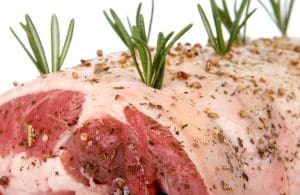
Colour: The colour of the meat should be bright red, not brown or grey. The fat should be white or creamy, usually not yellow which is a sign of ageing (or your meat could be from beef cattle raised on organic grass that includes American corn-fed cattle, which is fine). If the fat is green, it can be cut out since it is a moisture issue or it’s a green dye used for the info stamp when butchering.
- Marbling: Marbling is the fine streaks of fat within the muscle. It adds flavour and tenderness to the meat, so look for cuts with a good amount of marbling
- Ageing: Ageing is the process of hanging the meat in controlled conditions to improve its texture and flavour. The longer the meat is aged, the more tender and tastier it becomes. Look for labels that indicate how long the meat has been aged, usually between 21 and 28 days
- Origin: The origin of the meat tells you where it comes from and how it was raised. Look for labels that show the country of origin, the farm or region, and any quality assurance schemes or animal welfare standards that the meat meets.
Christmas.co.uk TOP TIP: Be aware that most supermarket beef will usually be packaged soon after slaughtering so will not have time to mature. Because of this, look for darker meat since this will have been hung for some time. This might be the time to source a quality butcher with a great reputation – their meat might be a tad darker than you find in a supermarket but that’s down to the ageing process to give great tasting beef.
Types of cut for beef to consider
Beef comes in different types of cut, depending on which part of the animal it comes from and how it is prepared. Different cuts have different characteristics, such as tenderness, flavour and fat content, and are suitable for different cooking methods.
Christmas.co.uk TOP TIP: If you are buying beef on the bone, then allow 400g per person. For boneless beef joints, look to buy 200g to 250g per person. For example, a 2.25-2.75kg piece of beef rib will feed up to eight people.
Here are some of the most common types of cut and how to cook them:
- Roasting joints: These are large cuts of meat that are ideal for roasting in the oven. They include sirloin, ribeye, topside, silverside and brisket. Roasting joints are usually cooked on a high heat for a short time to brown the outside, then on a lower heat for a longer time to cook the inside to your liking. You can also add herbs, spices, vegetables and stock to enhance the flavour and make a gravy
- Steaks: These are smaller cuts of meat that are ideal for frying, grilling or barbecuing. They include fillet, sirloin, ribeye, rump and flat iron. Steaks are usually cooked on a high heat for a short time to seal in the juices, then on a lower heat for a few minutes to cook them to your preference. You can also season them with salt, pepper, garlic, butter or sauces to add flavour
- Stewing or braising cuts: These are tougher cuts of meat that are ideal for slow cooking in liquid. They include chuck, blade, shin, skirt and oxtail. Stewing or braising cuts are usually cooked on a low heat for a long time until they become tender and fall apart. You can also add vegetables, herbs, wine or beer to create a rich sauce or broth
- Mince: This is finely chopped meat that is ideal for making burgers, meatballs, pies or lasagne. Mince can be made from any part of the animal, but leaner cuts such as topside or silverside are preferred. Mince is usually cooked on a medium-high heat until browned, then combined with other ingredients such as onion, garlic, tomato sauce or cheese.
So, while many of us will opt to buy a roasting joint of beef, there’s nothing to stop you from being adventurous (or controversial!) on Christmas Day and dishing up a pie, burgers or even lasagne!
oooOooo
Gordon Ramsay – Two Sunday roast dinners
Perennial favourite Gordon Ramsay serves up two great Christmas roast beef dinner ideas here.
Cooking with his children, he offers up roast beef with a twist.
First up is a stuffed rib of beef with horseradish, plus Yorkshire puddings.
He also prepares an excellent beef and ale stew. This is served with mustard dumplings and twice-baked bubble and squeak jacket potatoes.
Gordon dishes up some very tasty dessert ideas too.
We found that this video works because he takes time to cook with his children and shows them techniques that most people want to know but miss.
The stuffed beef rib recipe is excellent, by the way!
oooOooo
How to cook the perfect beef roast at Christmas
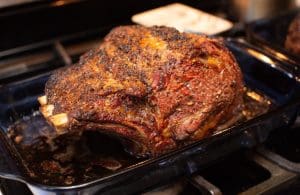
Bring the beef to room temperature: Take the beef out of the fridge at least an hour before cooking to allow it to come to room temperature. This ensures even cooking.
Preheat the oven: Preheat your oven to the recommended temperature for the cut you’re using. It’s usually best to start with a high heat and then turn it down after 20 minutes. For example, begin at 240C/475F/gas mark 9, and then turn down to 190C/375F/gas mark 5.
- Season generously: Rub the beef with a mix of salt and pepper – or your favourite herbs and spices to enhance the flavour.
- Basting: Most recipes will recommend basting the beef joint with juices from the pan. Some will say baste just once while others, such as Delia Smith, will recommend at least three times.
- Use a meat thermometer: Buy a quality meat thermometer to gauge accurately the internal temperature. This will help you achieve your finished roast – whether that be rare, medium-rare or medium.
- Rest the meat: Allow the beef to rest for 15-20 minutes after cooking before carving. This allows the juices to be redistributed, ensuring a juicy and tender roast.
Recipes for roast beef at Christmas
We think the BBC Good Food website offers some interesting recipes for roast beef at Christmas.
Among the offerings are beef fillet with horseradish and prosciutto, slow roasted rib of beef and beef wellington with a red wine gravy.
And who doesn’t like the sound of rare beef with mustard Yorkshire puddings?
The page also offers unusual recipes such as spiced roast beef and daube of beef with spiced beetroot.
Since beef is a sound alternative to turkey if you aren’t feeding a household of guests, the smaller cuts of beef make some of these recipes very attractive!
How to carve a roast beef joint
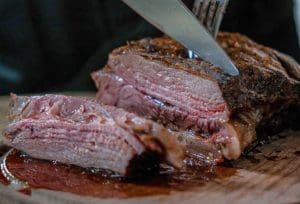
Here are some tips and tricks to help you slice your roast beef like a pro.
Let the meat rest. After taking your roast beef out of the oven, transfer it to a carving board and cover loosely with foil. Leave it to rest for at least 15 minutes so the juices redistribute and the meat relaxes. This will make it easier to carve and more tender to eat.
- Choose the right knife. You’ll need a sharp carving knife with a long, thin blade to cut through the meat smoothly and evenly. You’ll also need a carving fork to hold the meat in place and guide your knife. Avoid using a serrated knife as it can tear the meat and make it look messy.
- Cut off the string. If your roast beef joint is tied with string, cut it off carefully with scissors or a small knife and discard it. The string helps the meat keep its shape while cooking, but you don’t need it anymore once it’s done.
- Find the grain. The grain is the direction that the muscle fibres run in the meat. You want to cut across the grain, not along it, to get thin slices that are easy to chew. To find the grain, look for the lines or striations on the surface of the meat and cut perpendicular to them.
- Start slicing. Place your carving fork in the centre of the meat and hold it firmly. Use your carving knife to make thin, even slices, starting from one end of the joint and working your way to the other. Cut as much as you need for your meal and leave the rest intact for later use.
- Serve and enjoy. Transfer your carved slices to a warm platter and serve with your favourite accompaniments, such as roast potatoes, Yorkshire pudding, gravy and horseradish sauce.
Ideas for Christmas beef side dishes
Let’s face it, a really great roast beef Christmas dinner, demands really great side dishes.
From flawlessly roasted potatoes to sprouts bursting with flavour, here are some ideas for you to generously heap onto your plate.
- Herby roast potatoes
- Crispy honey-roasted sprouts
- Carrot and parsnip gratin with stuffing top
- Potato and celeriac mash
- Pan-fried potatoes with dried oregano, garlic and chilli
- Sticky Chantenay carrots and parsnips
- Hasselback potatoes
- Pigs in blankets (obviously)
- Yorkshire puddings.
You can visit our page dedicated to creating the BEST Yorkshire puddings for your dinner table.
oooOooo
How to carve a roast beef rib joint at Christmas
Along with Jamie’s tips on how to carve a joint in his video above, we also liked this offering from Jose at Simplybeefandlamb.
He uses his skills to carve a rib of beef perfectly.
Carefully removing the ribs for later use, he then removes another bone from the base of the meat.
And with a sharp knife, he uses long strokes to deliver thin slices that show off the meat.
Be aware this is a mouth-watering video to watch!

